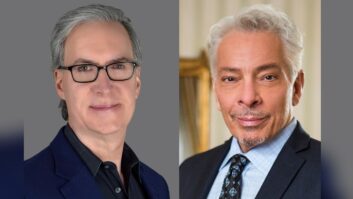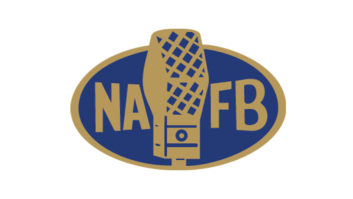This is the last in a three-part series. Part 1 explored changes in workflow as reported by broadcasters and our sponsors. Part 2 gave specific insights about how broadcasters have adjusted operations and what tools they’re using.
Writing about technical industries in general, Frederic Filloux on Medium.com recently predicted “a spectacular rise in remote working that will reshape the corporate tech world.” Among challenges confronting all managers are employees who no longer want to commute; close-packed office elevators; unsanitized hot desks; questions about how to enforce mask requirements; the need to rethink cubicle layouts; and many more.
Focusing on radio’s audio workflows, how will the trends discussed in this series change operations in months and years to come?
The challenges radio has faced would have seemed like science fiction until recently, said Rodrigo Poyatos Molero of Andalucía Este FM.
“It is clear that the way we make radio will change after Covid-19. But with the help of new remote control equipment, IP audio and shared files in the cloud, no listener will notice it, and we will be able to offer professional programming,” he said.
“We will return to the studios and make magic on the radio again. Stations need studios to centralize technical infrastructure and as a place to interview guests.”
By updating systems to continue broadcasting from remote locations and preparing for future emergencies, stations open up to the possibility of adding new on-air talent from anywhere with an internet connection, said ENCO’s Ken Frommert. “While most station personnel will return to their offices and studios in time, the cloud infrastructure will allow stations to find and voice track talent easier than ever before.”
Phil Zittel of Omnirax said, “Everyone is trying to predict what the ‘new normal’ will be, while looking for solutions to what once seemed like a temporary challenge but now appears to be a more permanent and evolving one. As companies re-populate their facilities and tweak them to meet social distancing guidelines, more and more employees will be forced to work from home.”
Zittel said this presents two immediate challenges. “With increasing reliance on remote technology necessitated by social distancing, facilities will transform to meet the new reality. Studios will be smaller, less guest-centric, modular, flexible, and geared toward supporting remote efficiencies.”
Also, people working from home need to be supported. “Their at-home work environment should promote health, happiness and increased productivity,” Zittel said.
“Working from home will be the new paradigm for the common industry,” agreed Pablo Rodriguez of Prodys. “However, broadcast professionals will return to work from the places where the ‘news’ happens. In future, outside broadcasts will benefit from all the infrastructure and training used during the pandemic.” He said Prodys plans to develop more for remote contribution, including adding video to audio capabilities.
At Entercom San Diego, J.R. Rogers and Bill Eisenhamer are working toward being able to switch talent to day-to-day remote operations pretty much on demand. If an air talent says, “I need to do a broadcast today,” the engineers want to reply, “Well, what kind of connectivity do you have?”
Says Eisenhamer, “You’ve got the Tieline Report IT app; and you get remote access to WideOrbit. The concept of putting remote console software on the WideOrbit machine allows them remote access to operate WideOrbit and to run their SAS console. Pending bandwidth, you can use the VPN access to access the AVT phone system and run the client; and how you have full control over your phones.”
Rogers adds that such flexibility also provides disaster recovery. He notes that their building sits under a low airline approach path. “There’s always a chance someone’s going to make a mistake; and if something unfortunate happens we have the ability to operate on an empty building while things are assessed.”
Claudio Donadei is CEO of Fulgor Service in Italy, which specializes in professional audio systems and
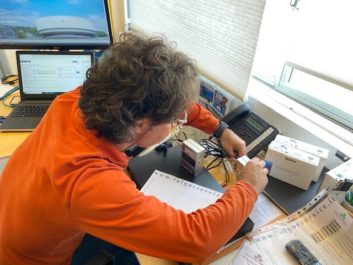
acoustic treatment in reverberant structures including churches.
“During this Covid-19 period we had to find new technologies that allows us to enable new workflows. As we deal with audio amplification and crowds are not allowed, we started using all those technologies that works on internet with data flows, streaming, etc.,” he said. The company uses Barix products.
“I think that all applications for mobile devices and software that simplify audio and video management will be of great interest for all people involved in this market,” Donadei continued. “In my opinion the demand of streaming devices will increase, people will get used more and more to this technology and the companies in the sector will use it more and more for two simple reasons: to decrease the possibility of contagion and to decrease the costs. Everything related to streaming will be the new business.”
Human contact, he added, will “remain fundamental.”
The crisis shows that fresh ways to create, edit, mix and broadcast are possible, said Gustavo Robles of AEQ. “Some of the changes will produce excellent results and will become the new standard in the market, some others will need more time and changes to succeed. But ultimately this health crisis will force all actors in the radio industry to adapt.”
Talent will work from home, radio studios will be in general smaller. Remote control will be a “must” in new devices. “In some countries analog technology will finally fully disappear because it cannot offer the capabilities of IP digital material to adapt to this situation. And for sure, IP, internet, DSL and 4G/5G connectivity will be mandatory in important projects, if was not already included.”
“I believe that as we start to ease back into things, new challenges will arise,” said Robert Ferguson of Wheatstone.
“Technology is always moving and evolving forward, and everyone is curious what the post pandemic world will be like. I think it depends on many factors and will be different from group to group and market to market.”
For broadcast shows with live talent, Ferguson doesn’t expect the traditional studio to go away anytime soon. “The chemistry between hosts is one of those things that is impossible to do with being remote and having varying lag times between them.”
He said remote talent, voicetracking and even production workflows have been around for some time. “I think those will continue and expand as necessary for some. Virtual workflows, cloud-based systems, are continually evolving and the requirements for them are rapidly advancing. These advances will allow for more capabilities in broadcaster workflows, either in the office/studio or remote. Everything from station management to sales, programming and promotions will see advantages to these advances,” Ferguson believes.
“Some think that traditional office life may never come back. Some think that nothing at all will change. I see it somewhere in the middle, and again it depends on the goal of the broadcaster. Smaller spaces or allowing remote work flexibility, yes those are coming. The economic impact of this issue will dictate some of that, as many may need to keep costs as low as possible until the economy recovers and revenues start coming back.”
Remote work certainly will increase, said Reto Brader of Barix, due to the easy setup now available at home; but shared working will still play an important role.
“In particular the remote group approach will gain momentum,” he said. “Most remote radio broadcasts so far were a single person, or a remote studio feeding back to the main site. Now it has become more common to do a show with three or more people, all at different locations. This will probably survive the work-from-home mandate during this health crisis.”
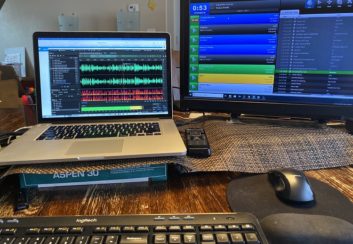
Ayrton Mcphail of Baker Broadcasting believes in the power of radio and that our industry will bounce back. Remote access will give stations more flexibility.
“Have a jock that gets hurt and can’t physically come to the station? No prob. They now have the ability to do their work from home and keep the income flowing. Same goes for trafficking.” (He adds jokingly that sick days are no excuse anymore.)
Marty Sacks of the Telos Alliance said we will see much more broadcasting from outside the traditional facility going forward. “The tools are available, primarily related to AoIP; the tech just works; and some facilities will have a smaller physical footprint as a result.” While COVID has forever changed our industry, Sacks said the news isn’t all bleak.
“Remote broadcasting is possible today and we are working to build new, innovative ways to make it even easier — with flexible business models to match. Much of this will take advantage of the advancements in the IT industry.”
Charlie Vollmer at Bloomberg said that in his personal opinion, there will be a lot of changes to the way many industries operate in the physical workplace. “Stations will need to have a diversified plan for deployment of people, equipment and offices. I think every employee needs to learn to work self-sufficiently. It’s important to keep your technical skills fresh and continually learn new systems and processes.”
Perhaps there will also be a renewed focus on creating full backup capabilities. For instance WAMU built a disaster recovery setup near its tower “just in case we run into trouble at our main facility,” Rob Bertrand said.
“Of course this crisis will change the industry,” said Digigram’s Xavier Allanic. “But the lockdown proved the ability of broadcasters to adapt fast to difficult situations and find smart and efficient solutions. So let’s consider this as opening opportunities for the future. This is even more important as broadcast is now a huge mix of audio and IT.”
As Doug Ferber of Tieline sees it, “Lots of radio companies were caught without a plan for large-scale remote broadcasting, so they slapped together low-cost and low-quality solutions as a fast fix to keep their live programming on the air,” he said.
“The longer air personalities broadcast from their homes, the more the need for better remote equipment will increase. The engineering community will find ways to smooth out the roughness of the short-term fixes through creative necessity and higher-quality equipment acquisition. And remote broadcasting ‘aint goin’ away.’ Fewer people in the studio building means stations don’t need all the space that they currently occupy,” he continued.
“In big markets, commercial office space in high-visibility buildings where radio companies like to operate from leases for $100 per square foot or more. Do the math. During an economic downturn, an industry that was already struggling will see this as an easy way to lower operating expenses. The remote equipment works great, the jocks like working from home (especially single parents), and the GM gets to run the place leaner.”
Ferber thinks that as broadcasting from home becomes more permanent, there will likely be more investment in better remote equipment. “More robust all-in-one solutions that stream, record, edit and play audio from several sources (some from other remote locations) will become even more popular.”
For certain, he said, remote control will be a key feature to any remote or home studio.
IP is now less frightening to users, said Yann Vonarburg of Aeta Audio Systems. Main control rooms now may be designed with more connectivity to the outside world, but he said in the near term, studio operations generally will still have value. “Nothing replaces a face-to-face discussion or a team around the table, especially in radio, where the audience has to ‘hear’ the mood.”
Still, he said, the crisis has taught that good radio can be done remotely on a daily basis when necessary, and that doing so can be a reliable alternative that provides flexibility and simplifies staff management.
“Some radio organizations could indeed be tempted to reduce studios and do everything remote or by relying more on cloud-based solutions, provided that they are secure enough. But that is the long term,” Vonarburg said.
Shultis at New York Public Radio expects there will be many permanent changes to the broadcast industry workplace and workflows.
“We are currently running an on-air fund drive with multiple hosts collaborating live on air from their home studios and taking physical cues using Zoom video conferencing in lieu of traditional face-to-face, in-studio collaboration,” he said.
“This workflow for live interviews will be the norm so as to minimize exposure to staff, i.e. leveraging phone and IP technologies for both audio and video feeds.”
He is interested to see what transpires with “live” music broadcasts; will they be limited to only the smallest of ensembles to fit on a stage with social distancing rules, or will they be relegated to something like Zoom meetings with the musicians performing live but in separate locations?
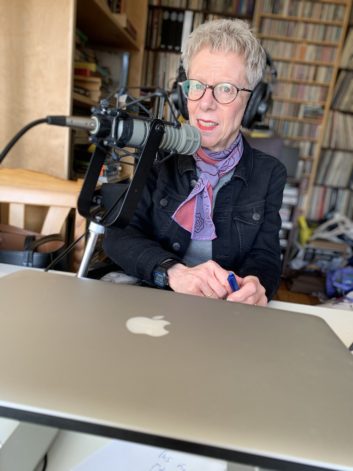
“We have a densely populated office and newsroom,” Shultis noted, “and have enjoyed the ease of collaboration and social interaction this open workspace has afforded us. Now this appears to be a liability, and we will have to re-think what our office and studios look like and function. We are engaging our architect for the effort and have created an internal task force to work with them and our various teams to devise both a physical and personnel scheduling plan that is safe and productive for our staff.”
“We will not always sit screening in our living rooms,” said Dan McQuillin of Broadcast Bionics. “But the creative possibilities have been expanded. This has accelerated the inevitable. Our industry was already changing. But it will change more quickly.”
CLOSING THOUGHTS
With so many businesses closed and people out of work, it’s an especially difficult time for the broadcast business, said Chris Crump of Comrex.
“Local advertising revenue is so important for our customers and ultimately for the broadcast equipment business, and it’s really taken a hit recently. First and foremost, we have to consider the health and safety of our employees during this pandemic which has certainly affected our daily operations.
“But the long-term is really uncertain. We think that social distancing is here to sta, and the majority of our customers have adapted to this quite nicely. But ‘Zoom fatigue’ and ‘quarantine fatigue’ have really made us all very antsy. We are really hoping that when the world reopens, our broadcast customers will take their listeners with them … wherever that might be.”
Steve Shultis recommends to his peers to make sure they have personal protective equipment at shared transmitter sites. “Early on we learned of an individual associated with a general contractor who works extensively for a master antenna site that had to quarantine due to exposure. That drove home the point for us that we had to make sure we had PPE to use at the sites when working with or around other entities.”
Rob Bertrand of WAMU emphasized that patience and trust are key, especially when answers are fluid.
“It’s also critical that we as technologists keep the uneasiness of air staff top of mind. It can be tempting to say ‘you just need to do X.’ But we need to remain mindful that they are dealing with the stresses of being the public name and voice of WAMU, doing that in an unfamiliar manner, and doing so from the otherwise private enclave of their home. Doing all that while also juggling parenting and other family commitments, while trying to deliver meaningful content is a real challenge.”
Consulting engineer Ed Bukont of E2 Technical Services says his rule in such situations is this: “Needs we accommodate; wants we discuss.”
“I have already heard some horror stories about managers demanding access to a VPN, with no idea what that is, or how to use it, but they think its direct access to their office PC. That’s not what a VPN is,” Bukont said. “Communication, patience, trust your engineer, are what will get you through this.”
“Radio has shown itself in a new light,” said Dan McQuillin of Broadcast Bionics. “For sure some of our commercial friends are having challenges because advertising revenue is strained. But our industry has never been stronger, more relevant, more urgent, more important. We are an industry that is fantastic at beating ourselves up. Please don’t. Give yourselves a round of applause. Audiences will never realize how abnormal this was and how much of this was made up on the hoof. And it sounded great.”
Gustavo Robles of AEQ gets the last word: “Radio is important. Projects are important. Business is important,” he said. “But health is more important. Take care and stay safe. These bad days of Covid-19 surely will pass.”
